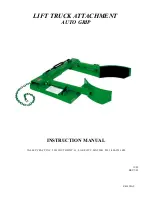
17
10
SAFETY INSTRUCTIONS
(continued)
Following operation or when unhooking, stop the tractor, set the brakes, shut off the engine, relieve all hydraulic
pressure and remove the ignition keys.
Store the unit in an area away from human activity. Do not permit children to play on or around the stored unit.
Do not park equipment where it will be exposed to livestock for long periods of time. Damage and livestock
injury could result.
Make sure all parked machines are on a hard, level surface and engage all safety devices. Storage location
should be level and solid to make connecting and unconnecting to power unit easy.
If blocking is used, make sure it is solid and secure before leaving area.
STORAGE SAFETY
Keep safety signs clean and legible at all times.
Replace safety signs that are missing or have become illegible.
Replaced parts that displayed a safety sign should also display the current sign.
Safety signs are available from your Distributor or Dealer Parts Department or the factory.
Be sure that the installation area is clean and dry. Be sure temperature is above 50°F (10°C).
Decide on the exact position before you remove the backing paper.
Remove the smallest portion of the split backing paper. Align the sign over the specified area and carefully
press the small portion with the exposed sticky backing in place.
Slowly peel back the remaining paper and carefully smooth the remaining portion of the sign in place. Small
air pockets can be pierced with a pin and smoothed out using the piece of sign backing paper.
How to Install Safety Signs:
SAFETY SIGNS
Safety is a primary concern in the design and
manufacture of our products. Unfortunately, our
efforts to provide safe equipment can be wiped out
by an operator’s single careless act.
In addition to the design and configuration of
equipment, hazard control and accident prevention
are dependent upon the awareness, concern, judge-
ment, and proper training of personnel involved in the
operation, transport, maintenance and storage of
equipment.
It has been said “The best safety device is an
informed, careful operator.” We ask you to be that
kind of operator.
The operator is responsible for the safe operation of
this equipment. The operator must be properly trained.
Operators should be familiar with the equipment, the
tractor, and all safety practices before starting operation.
Read the safety rules and safety decals on pages 3
through page 11.
OPERATING INSTRUCTIONS
■
■
Do not operate this product until you have posi-
tive indication that this attachment is securely
mounted to the loader. Failure to install lock pins or
have the latching mechanism engaged could result
in injury or death.
■
■
Power unit must be equipped with ROPS or
ROPS cab and seat belt. Keep seat belt securely fas-
tened. Falling off power unit can result in death from
being run over or crushed. Keep foldable ROPS sys-
tems in “locked up” position at all times.
■
■
Pallet Forks are NOT to be used for large round
bales, as this would create a hazardous condition.
■
■
Rear ballast is required to ensure 25% of gross
vehicle weight is transferred to the rear axle.
Attachment and load must be included as weight.
Adequate rear weights are required to counterbal-
ance maximum loader capacity and safe loader oper-
ation. Weight can be added as rear tire liquid, rear
wheel weights, rear axle weights and/or three point
hitch mounted ballast or implement. Ballasting will
vary with tractor and loader attachment. Refer to the
Tractor manual for recommended ballasting.
■
■
Never allow children or untrained persons to
operate equipment.
■
■
Keep bystanders away from equipment.
■
■
Never allow riders on power unit or attachment.
Beware of low electrical wires when loader is
raised. Serious injury or death can result if contact is
made.
Do not leave the operator’s seat if any part of the
power unit, loader or attachment contacts electric
lines.
■
■
Avoid carrying loose or shiftable loads. Falling
items could cause injury.
■
■
Beware of lift clearance when raising loader to
maximum height.
■
■
Always stop the power unit, set brake, shut off
engine, remove key, and lower loader to ground
before attempting to service. Never leave equipment
unattended with engine running.
OPERATION
——————————————————
Be sure tractor or skid steer is properly counter-
balanced with weights before attempting to lift any load.
Make sure fork latch is properly engaged.
Using the bucket tilt cylinders, adjust the angle of the
fork tines so they are parallel with the ground.
Adjust height of fork tines to enter the pallet to be
handled. Always keep the load or pallet as close to the
pallet fork main frame as possible.
Make sure weight of load is centered between the
forks.
Make sure all operators have read the Owner’s
Manual and are familiar with the instructions and the safe-
ty rules of operation.
WARNING
WARNING
CAUTION
DANGER



































